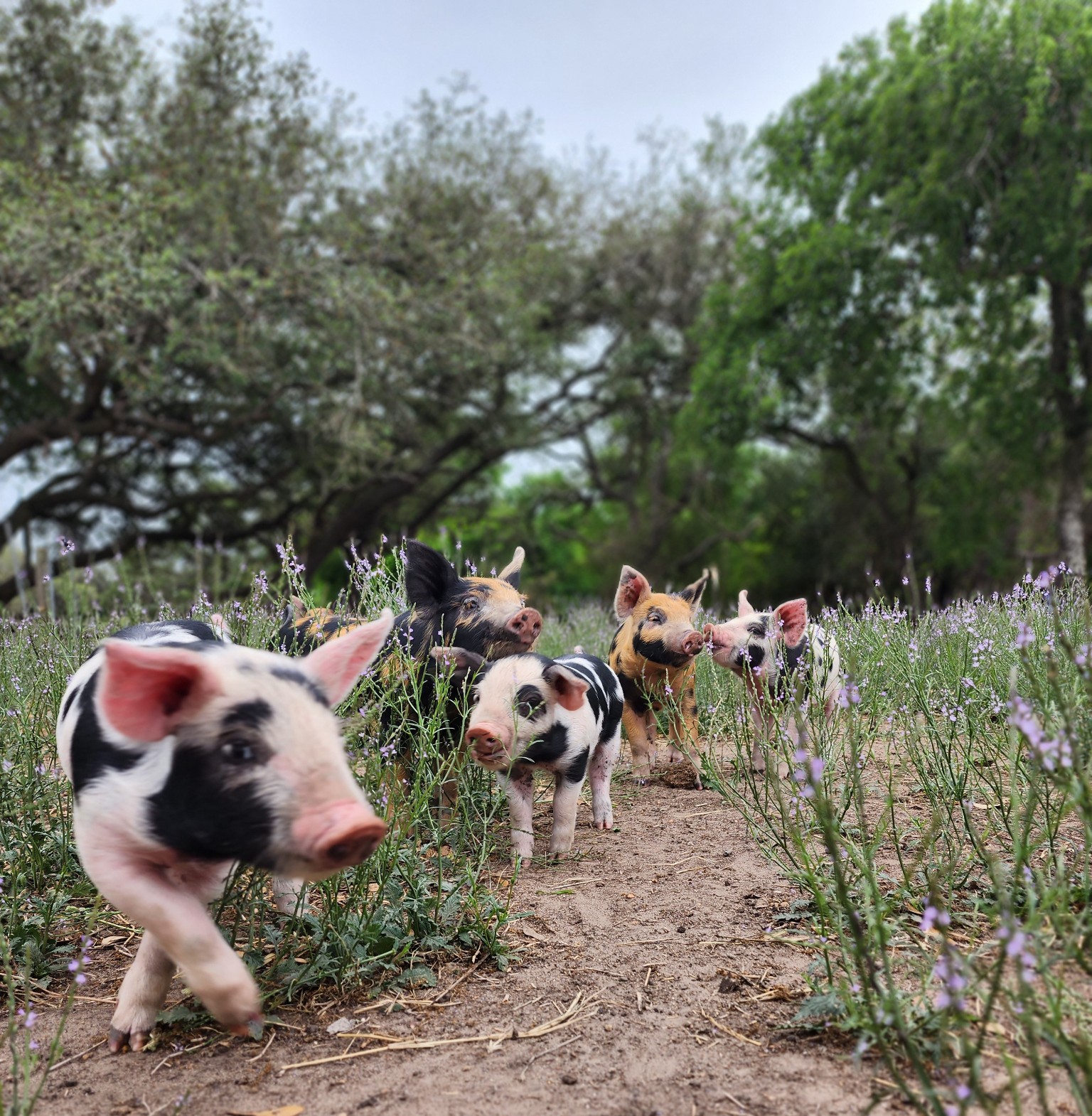The Klemckes discuss their regenerative farming methods at 1915 farm in Meyersville, Texas

Tanner and Catherine Klemcke were not planning to create a regenerative meat business when they bought their 57-acre property with a “free and unlivable” farmhouse on-site. The pair came from corporate jobs, and they thought that living on some land might provide “a mental getaway after long, hard days.” Neither had worked in agriculture before, and the source of their ingredients—particularly meat—was rarely a topic of consideration. “Livestock feeds millions of people, but most of our meat in the United States comes from a handful of companies [four total]—two of them are foreign owned. America is founded on agriculture, but today a lot of cattle that are born on family ranches end up in feed lots owned by one of four big conglomerates. People have really gotten away from the American farm,” Catherine says.
The Klemckes spent a couple years fixing up their farmhouse, and then one night, a Netflix documentary changed everything. They watched a documentary all about America’s meat industry. It sparked deeper research, informing the Klemckes on the unsustainable, wasteful, and inhumane practices that plague meat production. “We thought, ‘We’ll start farming!’” Catherine says.

1915 Farm’s pilot year launched with cows, chickens, and hogs, and by the fall, they had grass-fed beef, pasture-raised chicken, and heritage breed pasture pork ready to sell. Without farmers markets in Meyersville or the surrounding area, the Klemckes worked hard to market themselves, relying on Instagram and sharing their story (and the animals’ stories) on their website blog. With their online presence, Catherine worked to create awareness around conscious consumption, including working to be as close to zero-waste as possible. “It changes you as a person to raise livestock—to see them being born to taking them to the processor and getting the meat back—you don’t want anything to go to waste.”
Their product line evidences their commitment to utilizing the entire animal. You can find the expected, like grass-fed brisket, spare ribs, and sausage alongside dehydrated chicken feet, hearts, and tongue sold as pet treats. “We tried it because my first dog had hip dysplasia, and chicken feet are high in glucose—it’s so good for them, and she loved it. [These parts] aren’t in super high demand for people, so we’re able to dehydrate it and offer it for dogs.”
1915 Farm started small, filling 35 orders a month that they delivered between their home and Dallas. As their audience grew, they invested in shipping—a time-consuming process with lots of regulations—now they fulfill around 1,000 orders a month.
From the beginning, they knew they wanted to be as natural as possible, complete with healthy feed and a pasture environment for raising their animals. They read lots of blogs on regenerative livestock farming practices and, Catherine admits, a lot of it was trial and error.

“We work with Mother Nature and act more as a steward. There are ways to make animals grown faster, but we believer there are going to be long-term ramifications on our health and the effect of it on our grandkids.”
Rotational grazing of the herds is one of the primary pillars in their regenerative farming practices. “Livestock is here to improve pastures when grazed correctly,” Catherine explains. Each species takes turns grazing and fertilizing the pastures. Chickens may go first, eating pests, excreting, and stomping their nutrients into the earth. Once the grass regrows, the cows follow, fertilizing and treading the nutrients into the soil. Pigs might come after them, but generally, pigs and chickens maintain separate pastures (chickens need flat earth, while hogs like to root and wallow in the pastures). Depending on the weather, it takes anywhere from two to six months for the pasture to be ready for grazing again between the herds.
The lengthy process is challenging to scale, but the Klemckes intentionally keep 1915 Farm small in order to be sustainable. “Our type of regenerative farming may not be scalable, but it is replicable,” Catherine says. “It goes to show that if you provide a regenerative environment and be more of a steward, you produce a really high-quality product.”
Keep Reading
In the Field
Southern Makers: Heart and Spade Forge
In a world where most building pieces are premade and assembled, Jed Curtis is a rare person who wants to take raw materials and make something beautiful.
Southern Makers
Southern Makers: Tootsie Tomanetz
In Lexington, Texas, Tootsie Tomanetz, the 84-year-old pitmaster at Snow’s, was the catalyst that set the barbecue craze in motion.
Southern Makers
Southern Makers: Urban Asado
Meet Nick Carrera, the craftsman behind Urban Asado in St. Augustine, whose handcrafted Argentinian grills foster deliciousness and community.
share
trending content
-
FINAL VOTING for Your Favorite Southern Culinary Town
-
New Myrtle Beach Restaurants Making Waves
-
New Restaurants in Arkansas
-
Shrimp and Grits: A History
by Erin Byers Murray -
Tea Cakes, A Brief History
by TLP Editors
More From Southern Makers
-
A Spirited Approach with Wonderbird Spirits | Listen
-
Kuluntu Bakery Bakes Barriers | Listen
-
Scouting a Good Cup of Coffee | Listen
-
A Hot Take on Southern Chili Lab
-
Zero Proof Living with Sèchey and Target








